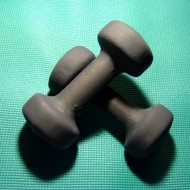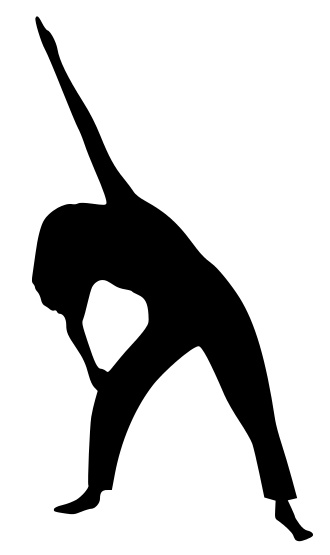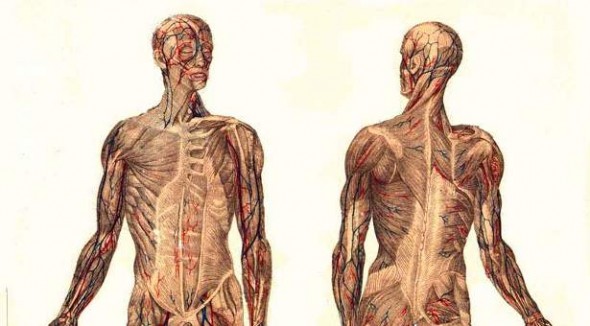“My love of movement” – an exercise in conversation with a personal trainer
- Published: November 28, 2015
Angela Bogner moved to Yellow Springs just over a year ago from California and took up residence as a personal trainer at the Wellness Center. According to her trainer biography, she believes that “our musculoskeletal and nervous systems tell our life stories and contain vast reserves of intelligence,” which is perhaps why she approaches training on a truly personal level: everyone’s life story is different, personal, and thus so are their abilities and interests and comfort levels. When fitness is tailored to an individual, it becomes a much more rewarding and productive experience for everyone. Angela has found that the joy of being able to move around all day and being able to share in the joy of recovery and progress makes for a profession that transcends the confines normally associated with “work.” She speaks below about her philosophy, her many areas of practice, and getting the most out of life through movement.
I’ve been involved in fitness almost my whole life. When I was in junior high, kind of against my will, my parents insisted that I join sports. So I ran track, I swam, I liked individual sports more. I found that I was a pretty good runner, so I did that all through high school. In my early 20s I moved to San Francisco, and I stopped being fit for a couple of years. Then I got reintroduced to fitness when I was college through a yoga class. I stumbled into yoga and I loved it. I started to practice yoga regularly, and eventually I became a yoga teacher. After that, I became interested in Pilates. At the time, it was, gosh, over fifteen years ago, there weren’t very many people doing Pilates at all. There were only a few other trainers in the city, so my business as a fully-certified Pilates trainer really took off. I was much busier as a Pilates instructor than I was a yoga teacher. Meanwhile, I had re-discovered my love of moving and I got very involved in dance in my early thirties, and I still dance.
I got into personal fitness training because I started to develop a dance injury, chronic knee problems, and everything I knew about Pilates and yoga just couldn’t seem to address my injury. So I went to a very experienced personal trainer who was used to working with dancers and athletes and she totally helped me. I managed not to have knee surgery and my problems were improved by 95%. So then I decided that I had to become a functional strength trainer, a personal trainer. I became a certified personal trainer through the National Association of Sports Medicine (NASM).
I definitely experience the world kinesthetically. Some people are visual learns, some auditory; it’s very important for me to feel things on a physical level. I tend to gravitate to movement activities. I love to dance. When I was in San Francisco, I took a variety of dance classes regularly and would sometimes perform. And when I can’t dance, I run. I’ve been running 5Ks and stuff like that, really enjoying it. My activities outside of my job are physically oriented – I love to hike, I love to be out there. When I run, it tends to be more of a zone, more of a meditative state, almost like no thought at all. With dancing, it’s almost like I’m communicating in another language, like it’s a whole language, a whole other universe and I’m moving around in it, communicating. It makes sense that I would gravitate to this type of work. I combined my skills in yoga, Pilates, strength training, my strengths as an athlete, and my experience as a dancer – I just kind of merged them.
 One of the most intense certifications I earned was definitely my Pilates trainer certification. That I earned about sixteen years ago. That was the old-fashioned way of doing it. You had to do an apprenticeship, something like one thousand hours. It took me two years to do. It was extremely detailed anatomy, then you apprentice for six months, you have to do all thesesteps before you actually become a trainer. You had to do interning and spend hours and hours observing in a studio. So that was definitely the most intense. My NASM certification training was pretty intense too. It was like a college course, probably a semester, and involves a lot of technical knowledge about kinesiology and physiology and nutrition. My Pilates certification doesn’t expire. The NASM, I have to renew it every two years. I also have a certification in senior fitness through ASFA, American Seniors Fitness Association, and that was tremendously valuable. I’m so glad I did it because it allowed me to feel so confident about taking seniors and very frail seniors on in my practice.
One of the most intense certifications I earned was definitely my Pilates trainer certification. That I earned about sixteen years ago. That was the old-fashioned way of doing it. You had to do an apprenticeship, something like one thousand hours. It took me two years to do. It was extremely detailed anatomy, then you apprentice for six months, you have to do all thesesteps before you actually become a trainer. You had to do interning and spend hours and hours observing in a studio. So that was definitely the most intense. My NASM certification training was pretty intense too. It was like a college course, probably a semester, and involves a lot of technical knowledge about kinesiology and physiology and nutrition. My Pilates certification doesn’t expire. The NASM, I have to renew it every two years. I also have a certification in senior fitness through ASFA, American Seniors Fitness Association, and that was tremendously valuable. I’m so glad I did it because it allowed me to feel so confident about taking seniors and very frail seniors on in my practice.
In personal training, with NASM at least, I really like their three-step approach to fitness. Step one is stability, meaning working on core stability and balance, and learning how to stabilize your joints. Then comes strength, where you focus on building strength. Step three is power, which is a more of an athletic-type training. Within those three steps are different phases. It’s called the Optimum Performance Training model, or OPT model. I do follow that model, more or less. But I also incorporate a lot of Pilates, in that I’m very specific about alignment and form. There’s no way I’m going to let someone use bad form, even if I seem a little nitpicky. If someone trains with me, they will have a lot of emphasis on core strength and balance. I put a lot of attention into [that aspect].
A lot of people have body image anxiety that makes physical activity seem very intimidating to them. I’ve had clients come in and say they were so scared that they wanted to turn around and run out. I’m very aware of body standards in our culture, and I try to ignore them completely. People say, “when I lose weight, I’ll start being more active.” Or that they don’t have time. They believe that they can’t make time in their schedules. Some people are afraid they won’t like exercise, that it will be boring or tedious, that they’ll do the same thing over and over again for an hour. If people say they don’t have time, I suggest they  write out their daily activities for a week. We can take a look at what they’ve written down and make time for them [to be active]. I suggest things like doing three ten-minute activities throughout the day, or two fifteen minute sessions. It makes no difference physiologically whether you do thirty minutes of intense stuff at once or divide it up throughout the day. Usually I can find something that appeals to someone. Not always, but usually.
write out their daily activities for a week. We can take a look at what they’ve written down and make time for them [to be active]. I suggest things like doing three ten-minute activities throughout the day, or two fifteen minute sessions. It makes no difference physiologically whether you do thirty minutes of intense stuff at once or divide it up throughout the day. Usually I can find something that appeals to someone. Not always, but usually.
I love cross training. Mixing it up is how you avoid boredom. If you do the same thing over and over again, your muscles are going to adapt in about four to six weeks, and then you’ll be losing about fifteen percent of your efficiency when you’re working out. It’s could to keep the muscles guessing. It’s good for the mind because it definitely staves off boredom. Right now I’m in my running phase, and I cross train to avoid injury.
Focusing on one muscle group to the point of exhaustion, doing bicep curls until your bicep is exhausted, and then doing hamstring curls until your hamstring is exhausted, isn’t the focusin fitness now. Now the focus is more on functional fitness, like how is this move going to help you in your daily activities? Strength-only would be a non-functional way of training. I’m all about functional fitness. I’m constantly thinking, “How is this going to help with agility? How’s it going to help with coordination? Balance and flexibility?” I’m always thinking in those terms, and if I don’t think an exercise is pertinent to those questions, then I don’t use it. I always say in my trainer biography that my philosophy is that the exercise must be functional, it must be fun and interesting, and it must be pertinent to the client’s abilities and fitness levels. I don’t have an agenda other than to help them meet their needs and goals. I’m not going to think a 94-year old woman should be doing bench presses.
As people age, no doubt we lose muscle mass and flexibility and coordination. I always thought that, as a dancer, if I keep doing this every day, I’m going to stay the same and still going to be able to do these great jumps and terms. And it’s not necessarily true. Ourresiliency definitely decreases. For some seniors, it can be a bit demoralizing, especially if they’ve been active previously. I know some of the seniors I work with who have had falls, they get really angry at themselves for having fallen. That surprised me. At least three of them said, “Oh, I’m so mad at myself.” I recognize that it’s very challenging to get old. Mentally and physically and psychologically, it’s very challenging. I have tremendous empathy, and I have a little fear of growing old myself.
It’s definitely rewarding to see people do things that they didn’t think they could do, and to progress from something they thought was really challenging to something that’s easy now. I really enjoy seeing my senior clients. Some of them have come in very, very, very frail, and to see them get stronger and stronger and more upright and balanced, that is extremely rewarding.
I have a client that has a serious medical challenge. He was told that he wouldn’t walk and would spend the rest of his life in a wheelchair, and he walks all over the place now. I’m not going to take credit for it, but he really, really works hard when he sees me. He takes it very seriously. I’m extremely proud of him. I have a 94 year-old woman who was extremely frail coming off a broken hip when I met her. She’s doing better and better and is able to walk with a cane now. She was on a walker and a wheelchair before.
I’m a contractor for the Wellness Center, and I have a few outside clients as well, but I’m also a TRE provider. TRE stands for Tension/Trauma Releasing Exercises. It’s a somatic practice designed to bring the body and the nervous system back into balance after stress or trauma. I’m what is called a TRE Provider. I’m the only one in Ohio that does it. I see individuals privately and work with groups. I’m running a group right now and it’s going very well. The group members are very receptive to it. I love being a personal trainer, but I’m really fascinated with this trauma work and I want to go in that direction as well.
TRE is a strictly physical approach to trauma and stress. TRE was developed by a clinical social worker – Dr. Berceli – who has spent decades and decades of his life working in warzones and natural disaster zones. He realized pretty early on that when you’re working with large traumatized populations, talk psychotherapy was not going to cut it. Trauma of that scale, stress of that scale, was not just a psychological event, it was a physical event too, meaning that our physiology changes, our musculoskeletal system changes. Until a person can release that extreme tension, they’re not going to feel better. In TRE we believe that a person does not have to revisit their trauma, nor even talk about it. A person can heal through physical exercises. There are seven physical exercises and they trigger this natural biological shaking mechanism that all mammals have in response to stress. Once a person has gone through TRE, they can expect their body to gently shake, tremor, vibrate, rock, and while they’re experiencing the shaking mechanism, they’re usually feeling thoughts of wellbeing and great calm, and also fascination, like, “wow, weird that my body is doing this.”
Some people, the minute they walk in the door, they’re ready and they’ll shake and tremor a lot during their first session. Others can take many sessions before they get there. I guess what influences a person’s experience of that release is how much trauma they’ve been exposed to recently, and their attitude about how to heal it. Sometimes when I’m working privately with TRE clients, they’ll say “this happened to me.” They’ll tell me in the beginning of a session, or during it. I don’t discourage them from talking about it, but I let them know that this is not psychotherapy and they’re not expected to share. If they want to, that’s OK, but they’re certainly not expected to. I don’t make any suggestions or anything; I just listen.
TRE is really catching fire with returning veterans suffering from PTSD. It’s not just some off the wall thing I learned in Califronia; it’s actually being used on veterans, thousands of people, and even just people who want less stress in their life. You don’t have to experienced trauma to benefit from it. I’m very intrigue with TRE. It’s not exactly a physical thing. I mean, there are exercises, but the exercises deal with helping people relieve stress on a deep, deep level. I’m completely fascinated with what I’m learning through that practice.
For now, I want to build up my TRE practice and my personal training practice. I’m thinking about getting another yoga teacher’s certification but haven’t decided. There’s no Pilates facility here, no Pilates studio, and I would love to bring that here. Pilates requires some really specific equipment. The equipment really costly, and one-on-one Pilates training is often expensive. But I have a business model that would make it less expensive; I know what type of equipment to use and I would want to focus on small group training, which is definitely more economical.
I was a social worker beforehand, and I did not really love that job. I really do enjoy working with people and trying to help people, but that job was really, really sad. I burned out very, very quickly. I worked in the field for less than ten years. Working as a personal trainer has definitely made me a happier person, more grounded. I know that after working in fitness and health and wellness for well over fifteen years, there’s no way I could go back to doing a sedentary profession. I’m so much happier. It’s definitely cemented the belief system I have, where I truly believe people must really like what they do for a living and not settle for less. It’s really made me confident about the belief that it’s really ok to love your job. It shouldn’t be any other way. Hold out until you find it. My work is tremendously meaningful to me, and I think that it’s meaningful to my clients. I don’t view it as just being an exercise instructor, I view it as healing, you know?

The Yellow Springs News encourages respectful discussion of this article.
You must login to post a comment.
Don't have a login? Register for a free YSNews.com account.














No comments yet for this article.